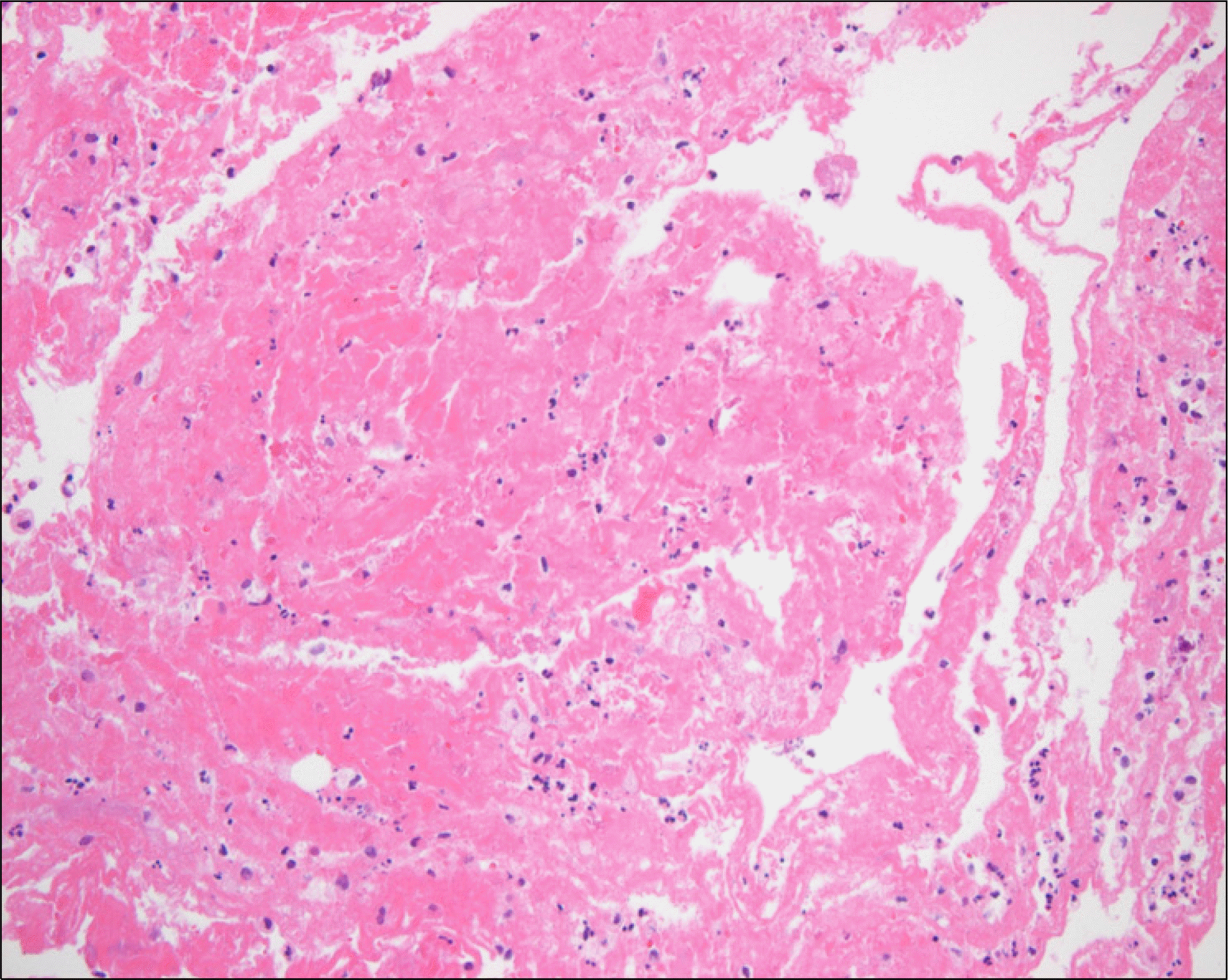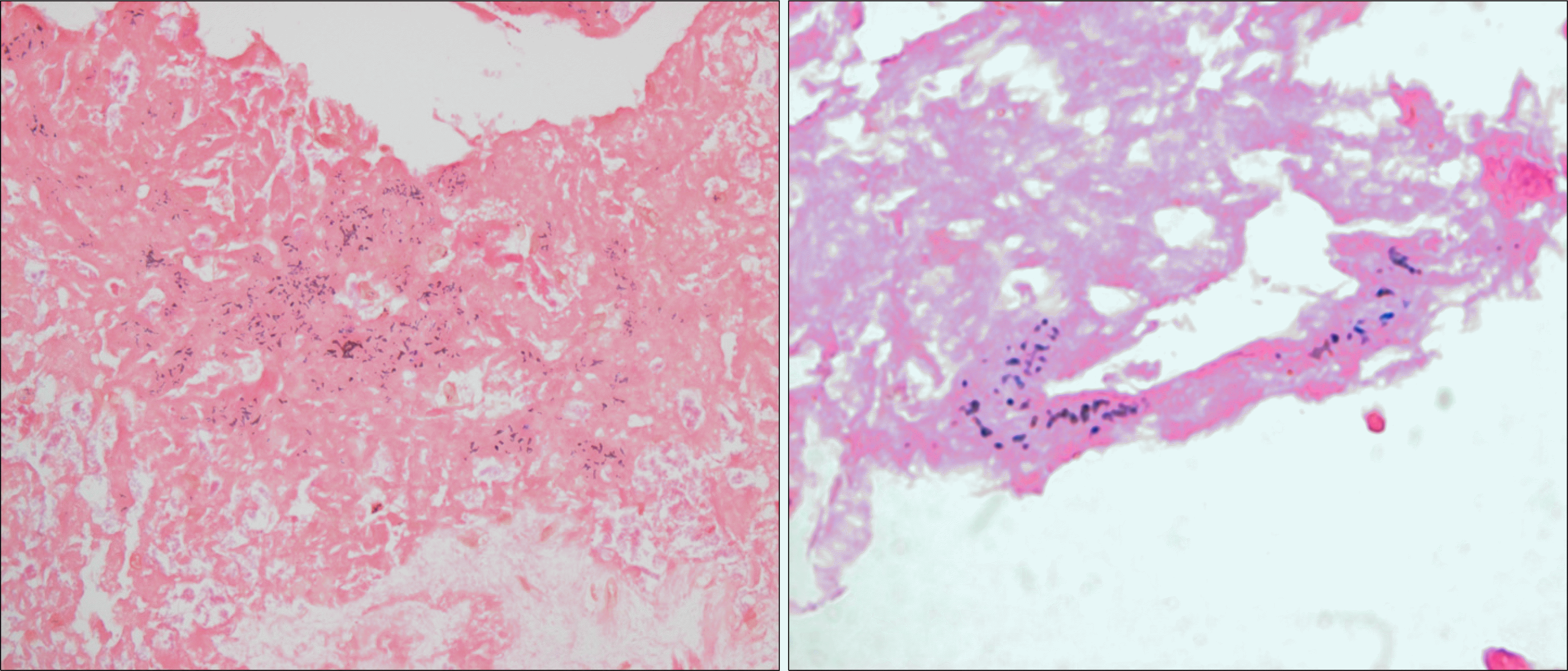Abstract
Bacillus cereus is a widespread organism in nature and a member of the B. cereus group of catalase-positive, aerobic, spore-forming, Gram-positive bacilli. B. cereus found in blood is often dismissed as a contaminant in the absence of repeated isolation from multiple cultures. Soft tissue and bone infection due to B. cereus have been associated with trauma, intravenous drug use, and an immunocompromised state. We report a very late prosthetic joint infection of the hip joint and consequent bacteremia caused by B. cereus, which occurred 13 years after total hip replacement surgery in the absence of recent trauma or intervention.
References
1. Logan NA, Popovic T, Hoffmaster A. Bacillus and other aerobic endospore-forming bacteria. Murray PR, Baron EJ, Jorgensen JH, editors. Manual of Clinical Microbiology. Washington, DC: ASM Press;2007. p. 455.
2. Kuroki R, Kawakami K, Qin L, Kaji C, Watanabe K, Kimura Y, et al. Nosocomial bacteremia caused by biofilm-forming Bacillus cereus and Bacillus thuringiensis. Intern Med. 2009; 48:791–6.

3. Park JH, Jang AS, Han SW, Kim YC, Lee KR, Park SH, et al. A case of bacillus cereus infection with pneumonia and bacteremia.
4. Nicholson WL, Munakata N, Horneck G, Melosh HJ, Setlow P. Resistance of Bacillus endospores to extreme terrestrial and extraterrestrial environments. Microbiol Mol Biol Rev. 2000; 64:548–72.
5. Luna VA, King DS, Gulledge J, Cannons AC, Amuso PT, Cattani J. Susceptibility of Bacillus anthracis, Bacillus cereus, Bacillus mycoides, Bacillus pseudomycoides and Bacillus thuringiensis to 24 antimicrobials using sensititre automated microbroth dilution and Etest agar gradient diffusion methods. J Antimicrob Chemother. 2007; 60:555–67.
6. Noble RC and Reeves SA. Bacillus species pseudosepsis caused by contaminated commercial blood culture media. JAMA. 1974; 230:1002–4.

7. Curtis JR, Wing AJ, Coleman JC. Bacillus cereus bacteraemia. A complication of intermittent haemodialysis. Lancet. 1967; 1:136–8.
8. Akesson A, Hedström SA, Ripa T. Bacillus cereus: a significant pathogen in postoperative and posttraumatic wounds on orthopaedic wards. Scand J Infect Dis. 1991; 23:71–7.
9. Lamagni T. Epidemiology and burden of prosthetic joint infections. J Antimicrob Chemother. 2014; 69(Suppl 1):i5–10.

10. Lindsay D, Brözel VS, Von Holy A. Biofilm-spore response in Bacillus cereus and Bacillus subtilis during nutrient limitation. J Food Prot. 2006; 69:1168–72.

11. Costerton JW. Biofilm theory can guide the treatment of device-related orthopaedic infections. Clin Orthop Relat Res. 2005. 7–11.

12. Peel TN, Cheng AC, Buising KL, Choong PF. Microbiological aetiology, epidemiology, and clinical profile of prosthetic joint infections: are current antibiotic prophylaxis guidelines effective? Antimirob Angents Chemother. 2012; 56:2386–91.

13. Dubouix A, Bonnet E, Alvarez M, Bensafi H, Archambaud M, Chaminade B, et al. Bacillus cereus infections in traumatology-orthopaedics department: retrospective investigation and improvement of healthcare practices. J Infect. 2005; 50:22–30.

14. Gallo PH, Melton-Kreft R, Nistico L, Sotereanos NG, Sewecke JJ, Stoodley P, et al. Demonstration of Bacillus cereus in orthopaedic-implant-related infection with use of a multi-primer polymerase chain reaction-mass spectrometric assay: report of two cases. J Bone Joint Surg Am. 2011; 93:e85.
15. Kim MJ, Chang BH, Kim IC, Lee DW, Ahn M. Posttraumatic Bacillus cereus endophthalmitis. J Korean Ophthalmol Soc. 2005; 46:1597–604.




 PDF
PDF ePub
ePub Citation
Citation Print
Print




 XML Download
XML Download